专八语言学整理
- 格式:doc
- 大小:132.50 KB
- 文档页数:16
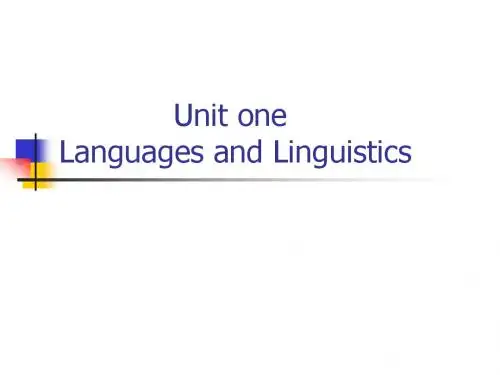
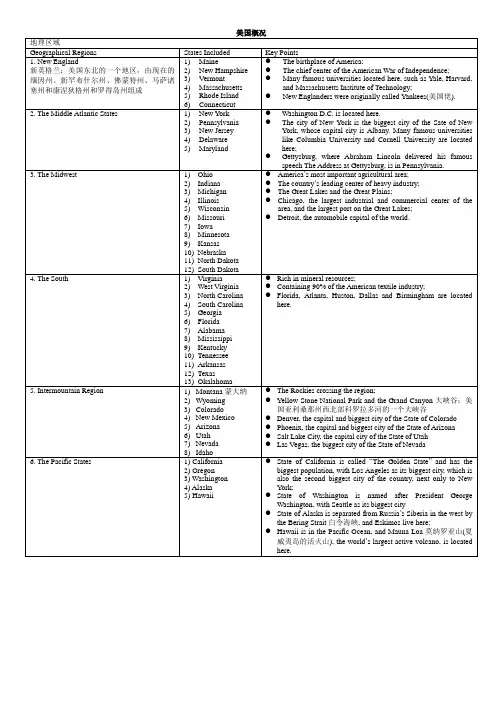
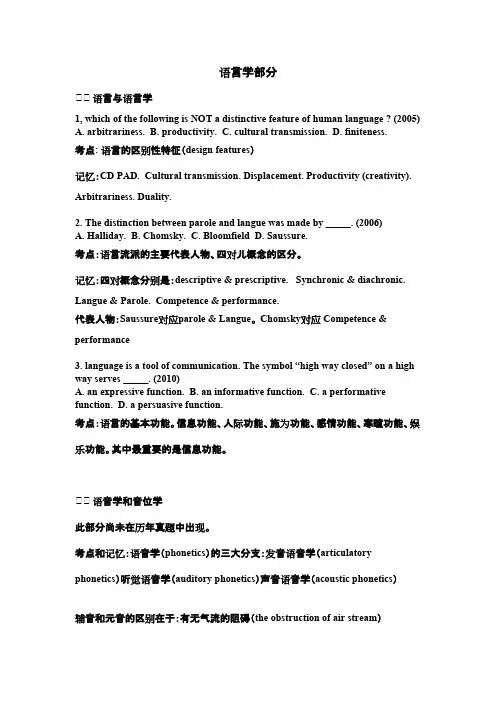
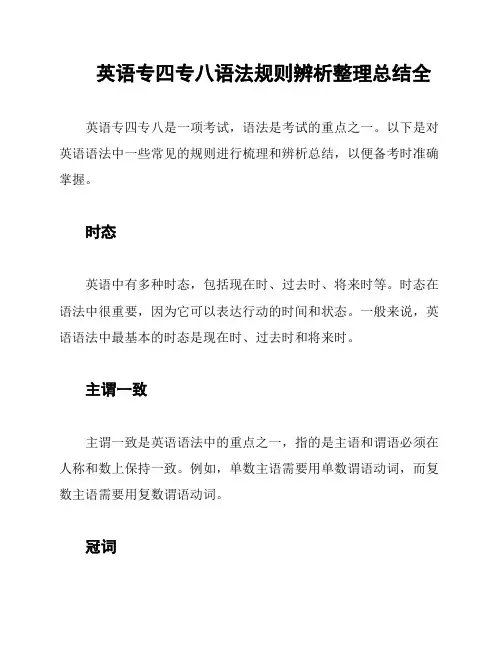
英语专四专八语法规则辨析整理总结全
英语专四专八是一项考试,语法是考试的重点之一。
以下是对英语语法中一些常见的规则进行梳理和辨析总结,以便备考时准确掌握。
时态
英语中有多种时态,包括现在时、过去时、将来时等。
时态在语法中很重要,因为它可以表达行动的时间和状态。
一般来说,英语语法中最基本的时态是现在时、过去时和将来时。
主谓一致
主谓一致是英语语法中的重点之一,指的是主语和谓语必须在人称和数上保持一致。
例如,单数主语需要用单数谓语动词,而复数主语需要用复数谓语动词。
冠词
英语语法中有三种冠词:a、an和the。
a和an是不定冠词,表示单数可数名词,而the是定冠词,表示特定的人、物、地点等。
名词
英语语法中有三种名词:可数名词、不可数名词和集合名词。
可数名词可以与数词连用表示数量,不可数名词不能与数词连用,集合名词表示由众多相似个体组成的群体。
动词
动词是英语语法中最重要的部分之一。
动词有时态、语态和语气等方面的变化,动词的不同形式反映了不同的语法含义。
形容词和副词
英语语法中的形容词和副词是修饰词,用于描述名词和动词。
形容词一般在名词前面使用,副词则用于修饰动词、形容词和其他副词。
介词
英语语法中的介词用于表示时间、空间和关系等。
介词通常出现在名词或代词之前,用于指示它们与其他单词之间的关系。
以上是英语专四专八语法的规则辨析整理总结,希望对备考的同学有所帮助。
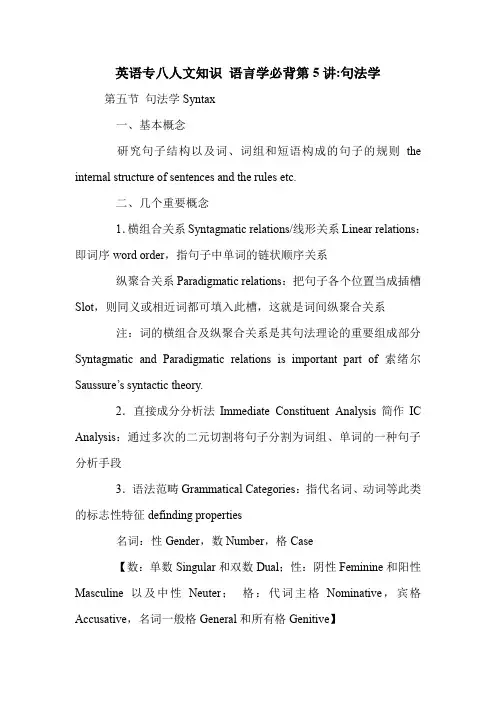
英语专八人文知识语言学必背第5讲:句法学第五节句法学Syntax一、基本概念研究句子结构以及词、词组和短语构成的句子的规则the internal structure of sentences and the rules etc.二、几个重要概念1.横组合关系Syntagmatic relations/线形关系Linear relations:即词序word order,指句子中单词的链状顺序关系纵聚合关系Paradigmatic relations:把句子各个位置当成插槽Slot,则同义或相近词都可填入此槽,这就是词间纵聚合关系注:词的横组合及纵聚合关系是其句法理论的重要组成部分Syntagmatic and Paradigmatic relations is important part of 索绪尔Saussure’s syntactic theory.2.直接成分分析法Immediate Constituent Analysis简作IC Analysis:通过多次的二元切割将句子分割为词组、单词的一种句子分析手段3.语法范畴Grammatical Categories:指代名词、动词等此类的标志性特征definding properties名词:性Gender,数Number,格Case【数:单数Singular和双数Dual;性:阴性Feminine和阳性Masculine以及中性Neuter;格:代词主格Nominative,宾格Accusative,名词一般格General和所有格Genitive】动词:时态Tense,体Aspect,语态V oice三、关于句子:the maximum free form最大的语法分析单位1.句子关系:一致关系Agreement:两个或更多单词在某个特定环境下必须保持其某个范畴的一致,主要表现在主谓、修饰语和被修饰语之间。
如this man/these men支配关系Government:一个或几个单词因受到其他相邻词语的支配而必须与或者保持某个范畴的一致,如代词在动词后必须成宾格状态beat him等2. 句子的扩展Extension of sentence三种方法:结合Conjoining,嵌入Embedding和递归Recursiveness3. 句子结构向心结构Endocentric construction:具有核心的结构体。
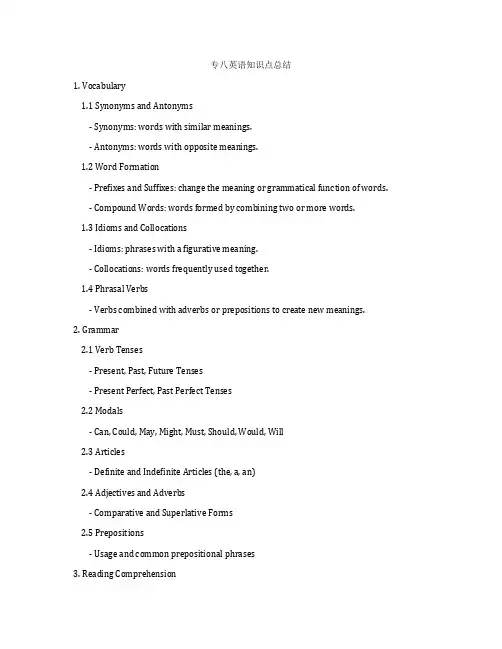
专八英语知识点总结1. Vocabulary1.1 Synonyms and Antonyms- Synonyms: words with similar meanings.- Antonyms: words with opposite meanings.1.2 Word Formation- Prefixes and Suffixes: change the meaning or grammatical function of words. - Compound Words: words formed by combining two or more words.1.3 Idioms and Collocations- Idioms: phrases with a figurative meaning.- Collocations: words frequently used together.1.4 Phrasal Verbs- Verbs combined with adverbs or prepositions to create new meanings.2. Grammar2.1 Verb Tenses- Present, Past, Future Tenses- Present Perfect, Past Perfect Tenses2.2 Modals- Can, Could, May, Might, Must, Should, Would, Will2.3 Articles- Definite and Indefinite Articles (the, a, an)2.4 Adjectives and Adverbs- Comparative and Superlative Forms2.5 Prepositions- Usage and common prepositional phrases3. Reading Comprehension3.1 Main Idea and Supporting Details3.2 Inference and Interpretation3.3 Vocabulary in Context3.4 Text Structure and Organization4. Listening Comprehension4.1 Listening for Main Ideas4.2 Identifying Details4.3 Inference and Interpretation4.4 Note-taking and Summarizing5. Writing5.1 Essay Structure- Introduction, Body, Conclusion5.2 Cohesion and Coherence5.3 Paragraph Development- Topic Sentences, Supporting Details, Transitions5.4 Grammar and Vocabulary Usage6. Speaking6.1 Fluency and Pronunciation6.2 Vocabulary and Grammar Accuracy6.3 Speaking with Confidence6.4 Responding to Questions and Prompts7. Test-taking Strategies7.1 Time Management7.2 Effective Note-taking7.3 Skimming and Scanning7.4 Elimination of Answer ChoicesIn summary, the Special English Examination tests various language skills including vocabulary, grammar, reading comprehension, listening comprehension, writing, speaking, and test-taking strategies. It is important for test-takers to review and practice each of these knowledge points in order to achieve success on the examination.。
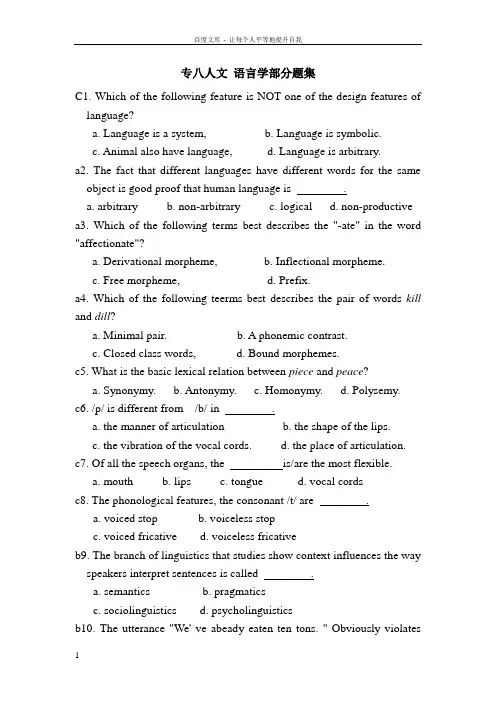
专八人文语言学部分题集C1. Which of the following feature is NOT one of the design features of language?a. Language is a system,b. Language is symbolic.c. Animal also have language,d. Language is arbitrary.a2. The fact that different languages have different words for the same object is good proof that human language is .a. arbitraryb. non-arbitraryc. logicald. non-productive a3. Which of the following terms best describes the "-ate" in the word "affectionate"?a. Derivational morpheme,b. Inflectional morpheme.c. Free morpheme,d. Prefix.a4. Which of the following teerms best describes the pair of words kill and dill?a. Minimal pair.b. A phonemic contrast.c. Closed class words,d. Bound morphemes.c5. What is the basic lexical relation between piece and peace?a. Synonymy.b. Antonymy.c. Homonymy.d. Polysemy.c6. /p/ is different from /b/ in .a. the manner of articulationb. the shape of the lips.c. the vibration of the vocal cords.d. the place of articulation.c7. Of all the speech organs, the is/are the most flexible.a. mouthb. lipsc. tongued. vocal cordsc8. The phonological features, the consonant /t/ are .a. voiced stopb. voiceless stopc. voiced fricatived. voiceless fricativeb9. The branch of linguistics that studies show context influences the way speakers interpret sentences is called .a. semanticsb. pragmaticsc. sociolinguisticsd. psycholinguisticsb10. The utterance "We' ve abeady eaten ten tons. " Obviously violatesthe maxim of .a. qualityb. quantityc. relationd. mannera11. All the back vowels in English are pronounced with rounded-lips, i. e. rounded, Except .a./a:/b./u/c./3: /d./u/b12. The semantic relationship between the two sentences "Mary' s son is an engineer" and "Mary has a son" is .a. entailmentb. presuppositionc. synonymyd. inconsistencyd13. Which of the following sentences is a commissive?a. The earth is round.b. I now pronounce you husband and wife.c. I' m really sorry !d. I' 11 be here tomorrow.a14. Semantic feature analysis attempts to account for the of a word according to the presence or absence of a specific semantic feature in the word.a. conceptual meaningb. social meaningc. connotative meaningd. affective meaningc15. act is the extra meaning of the utterance produced on the basis of its literal meaning.a. Speechb. Locutionaryc. Illocutionaryd. Perlocutionarya16. is a group of people using a given language or dialect. They use the same kind of language or dialect which is highly stratified in terms of social division.a. Speech communityb. Individual dialectc. Regional dialectd. Social dialecta17. The situation where two very different varieties of the same language are used side by side for two different sets of functions is termed asa. diglossiab. bilingualismc. muhilingualismd. registera18. A is a variety of a language that is not a native language of anyone, but is learned on contact situation such as trading.a. pidginb. creolec. dialectd. lingua francac19. The word "lab" is formed througha. back formationb. blendingc. clippingd. derivation d20. Which of the following items is not one of the grammatical categories of English pronouns ?a. Genderb. Numberc. Cased. V oiceb21. The pair of words "lend" and "borrow" area. gradable oppositesb. converse oppositesc. co-hypinymsd. synonymsb22. "Big" and "Small" are a pair of opposites.a. complementaryb. gradablec. completed. converseb23. is the study of how speakers of a language use sentences to effect successful communication.a. Semanticsb. Pragmaticsc. Sociolinguisticsd. Psycholinguisticsa24. A variety of a language used recognizably in a specific region or by a specific social class is called aa. dialectb. registersc. creolesd. pidginsb25. In a speech community people have something in common---a language or a particular variety of language and rules for using it.a. sociallyb. linguisticallyc. culturallyd. pragmaticllya26. [1] and [r] function in a minimal pair ofa. lid and ridb. lad and redc. peel and peard. Both a, b and c.c27. Man' s linguistic ability enables him to produce and understand an infinitely large number of sentences in his native language, including the sentences which were never heard before. This design feature of language is .a. specializationb. cultural transmissionc. productivityd. arbitrarinessb28. The study of language development over a period of time is generally termed as linguistics, which focuses on the changesand developments of language.a. comparativeb. appliedc. synchronicd. diachronicd29. Human language operates on two levels of structure. At on elevel are elements which have no meaning in themselves but which combine to form units at another level which do have meaning. This design feature of language is calleda. displacementb. dualityc. arbitrarinessd. interchangeabilitya30. If three consonants could cluster together at the beginning of a word, the first phoneme must bea. [s]b.[t]c.[1]d.[p]c31. A is the smallest meaningful phonetic segment of an utterance on the level of parole.a. morphemeb. phonec. phonemed. morphc32. There are different types of affixes or morphemes. The affix "ed" in the word learned is known as a (n) .a. derivational morphemeb. free morphemec. inflectional morphemed. free formb33. is a sub-field of linguistics that studies the sentence structure of language.a. Morphologyb. Syntaxc. Semanticsd. Pragmatics a34. The concept of the minimal pair is proposed for identifying .a. phonemesb. allophonesc. morphemesd. allomorphs c35. In the following conversation:A: Beirut is in Peru, isn' t it?B: And Rome is in Romania, 1 suppose.B violates thea. Quality Maximb. Quantity Maximc. Relation Maximd. Manner Maximb36. The semantic relationship between flower and rose isa. hyponymsb. hyponymyc. co-hymonymsd. superodinatec37. The word " unhappiness" has morphemes.a. oneb. twoc. threed. foura38. Which of the following sound is diphthong?a. [ai]b. [t]c. [dv]d. [A]c39. "Hot dog" with the first element stressed means .a. a dog which is notb. a barking dogc. a kind of foodd. a dead dogb40. The plural affix in the word table is a(n) .a. inflectional suffixb. derivational suffixc. free morphemed. rootc41. In first language acquisition children usually grammatical rules from the linguist information they hear.a. useb. acceptc. generalized. reconstructd42. According to Krashen, refers to the gradual and subconscious development of ability in the first language by using it naturally in daily communicative situations.a. learningb. competencec. performanced. acquisitiond43. The criterion used in IC analysis isa. transformationb. conjoiningc. groupingd. substitutabilityb44. Which branch of phonetics concerns the production of speech sounds?a. Acoustic phoneticsb. Articulatory phoneticsc. Auditory phoneticsd. Neither of themd45. refers to the study and analysis of the mistakes made by second and foreign language learners.a. Contrastive analysisb. Error analysisc. Interlanguaged. The behaviorist approach参考答案1-5 caaac 6-10 cccbb 11-15 abdac 16-20 aaacd 21-25 bbbab 26-30 acdba 31-35 ccbac 36-40 bcacb 41-45 cddbb。
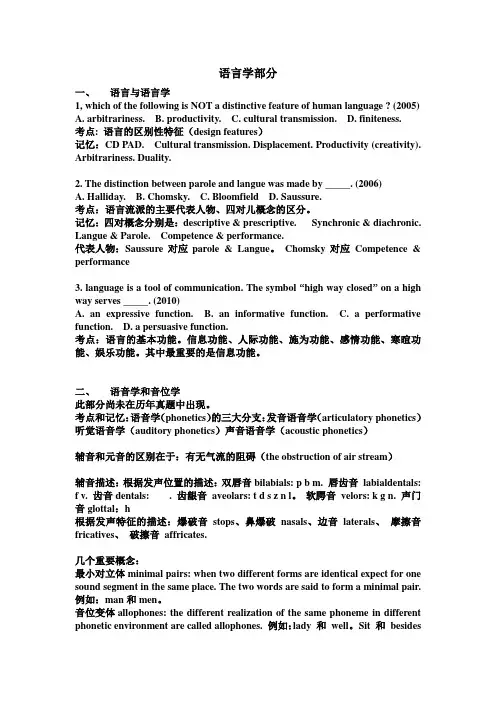
语言学部分一、语言与语言学1, which of the following is NOT a distinctive feature of human language ? (2005) A. arbitrariness. B. productivity. C. cultural transmission. D. finiteness.考点: 语言的区别性特征(design features)记忆:CD PAD. Cultural transmission. Displacement. Productivity (creativity). Arbitrariness. Duality.2. The distinction between parole and langue was made by _____. (2006)A. Halliday.B. Chomsky.C. BloomfieldD. Saussure.考点:语言流派的主要代表人物、四对儿概念的区分。
记忆:四对概念分别是:descriptive & prescriptive. Synchronic & diachronic. Langue & Parole. Competence & performance.代表人物:Saussure对应parole & Langue。
Chomsky对应Competence & performance3. language is a tool of communication. The symbol “high way closed” on a high way serves _____. (2010)A. an expressive function.B. an informative function.C. a performative function.D. a persuasive function.考点:语言的基本功能。
![[训练]语言学笔记-用于专八及一般期末考试](https://uimg.taocdn.com/6fa4b497cd22bcd126fff705cc17552707225e37.webp)
第一节语言的本质一、语言的普遍特征(Design Features)1. 任意性Arbitratriness:shu 和Tree都能表示“树”这一概念;同样的声音,各国不同的表达方式2. 层结构Duality:语言由声音结构和意义结构组成(thestructure of sounds and meaning)3. 多产性productive:语言可以理解并创造无限数量的新句子,是由双层结构造成的结果(Understand and createunlimited number with sentences)4. 移位性Displacemennt:可以表达许多不在场的东西,如过去的经历、将来可能发生的事情,或者表达根本不存在的东西等5. 文化传播性Cultural Transmission:语言需要后天在特定文化环境中掌握二、语言的功能(Functions of Language)1. 传达信息功能Informative:最主要功能The main function2. 人际功能Interpersonal:人类在社会中建立并维持各自地位的功能establish and maintain theiridentity3. 行事功能performative:现实应用——判刑、咒语、为船命名等Judge,naming,and curses4. 表情功能Emotive:表达强烈情感的语言,如感叹词/句exclamatory expressions5. 寒暄功能Phatic:应酬话phatic language,比如“吃了没?”“天儿真好啊!” 等等6. 元语言功能Metalingual:用语言来谈论、改变语言本身,如book可以指现实中的书也可以用“book这个词来表达作为语言单位的“书”三、语言学的分支1. 核心语言学Core linguistic(1)语音学Phonetics:关注语音的产生、传播和接受过程,着重考察人类语言中的单音。
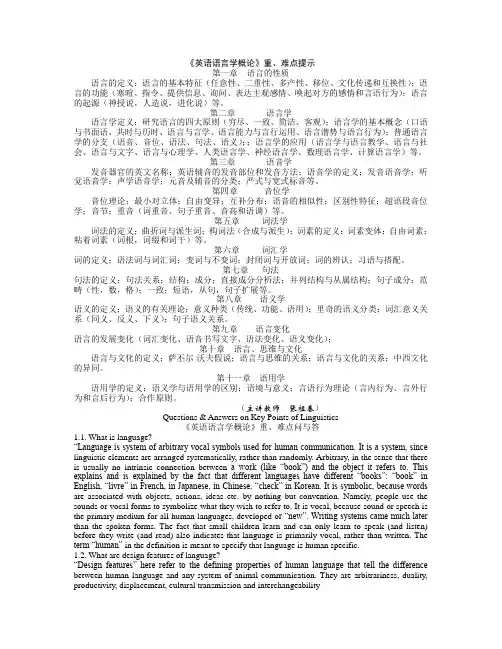
《英语语言学概论》重、难点提示第一章语言的性质语言的定义:语言的基本特征(任意性、二重性、多产性、移位、文化传递和互换性);语言的功能(寒暄、指令、提供信息、询问、表达主观感情、唤起对方的感情和言语行为);语言的起源(神授说,人造说,进化说)等。
第二章语言学语言学定义;研究语言的四大原则(穷尽、一致、简洁、客观);语言学的基本概念(口语与书面语、共时与历时、语言与言学、语言能力与言行运用、语言潜势与语言行为);普通语言学的分支(语音、音位、语法、句法、语义);;语言学的应用(语言学与语言教学、语言与社会、语言与文字、语言与心理学、人类语言学、神经语言学、数理语言学、计算语言学)等。
第三章语音学发音器官的英文名称;英语辅音的发音部位和发音方法;语音学的定义;发音语音学;听觉语音学;声学语音学;元音及辅音的分类;严式与宽式标音等。
第四章音位学音位理论;最小对立体;自由变异;互补分布;语音的相似性;区别性特征;超语段音位学;音节;重音(词重音、句子重音、音高和语调)等。
第五章词法学词法的定义;曲折词与派生词;构词法(合成与派生);词素的定义;词素变体;自由词素;粘着词素(词根,词缀和词干)等。
第六章词汇学词的定义;语法词与词汇词;变词与不变词;封闭词与开放词;词的辨认;习语与搭配。
第七章句法句法的定义;句法关系;结构;成分;直接成分分析法;并列结构与从属结构;句子成分;范畴(性,数,格);一致;短语,从句,句子扩展等。
第八章语义学语义的定义;语义的有关理论;意义种类(传统、功能、语用);里奇的语义分类;词汇意义关系(同义、反义、下义);句子语义关系。
第九章语言变化语言的发展变化(词汇变化、语音书写文字、语法变化、语义变化);第十章语言、思维与文化语言与文化的定义;萨丕尔-沃夫假说;语言与思维的关系;语言与文化的关系;中西文化的异同。
第十一章语用学语用学的定义;语义学与语用学的区别;语境与意义;言语行为理论(言内行为、言外行为和言后行为);合作原则。
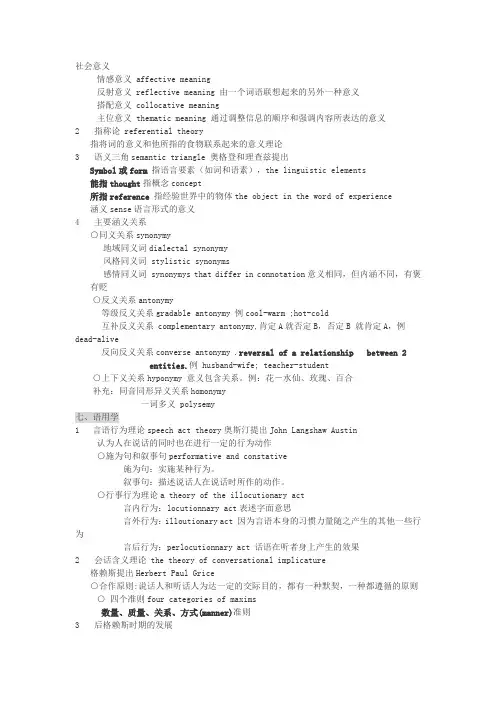
社会意义情感意义 affective meaning反射意义 reflective meaning 由一个词语联想起来的另外一种意义搭配意义 collocative meaning主位意义 thematic meaning 通过调整信息的顺序和强调内容所表达的意义2指称论 referential theory指将词的意义和他所指的食物联系起来的意义理论3语义三角semantic triangle 奥格登和理查兹提出Symbol或form指语言要素(如词和语素),the linguistic elements能指thought指概念concept所指reference指经验世界中的物体the object in the word of experience涵义sense语言形式的意义4主要涵义关系○同义关系synonymy地域同义词dialectal synonymy风格同义词 stylistic synonyms感情同义词 synonymys that differ in connotation意义相同,但内涵不同,有褒有贬○反义关系antonymy等级反义关系gradable antonymy 例cool-warm ;hot-cold互补反义关系 complementary antonymy,肯定A就否定B,否定B 就肯定A,例dead-alive反向反义关系converse antonymy .reversal of a relationship between 2 entities.例 husband-wife; teacher-student○上下义关系hyponymy 意义包含关系。
例:花-水仙、玫瑰、百合补充:同音同形异义关系homonymy一词多义 polysemy七、语用学1 言语行为理论speech act theory奥斯汀提出John Langshaw Austin认为人在说话的同时也在进行一定的行为动作○施为句和叙事句performative and constative施为句:实施某种行为。
专八语法知识点总结一、名词名词是表示人、事、物、地点等的名称的词,是英语中的一类词性,具有单数和复数的形式,以及可数和不可数的区分。
名词的用法包括名词的数、格、性和形式等方面。
1.名词的数名词具有单数和复数两种形式,单数表示一个,复数表示多个。
(1)名词的变化规则a. 大多数名词在词尾加-s或-es表示复数,如:book-books, box-boxes。
b. 以辅音字母+y结尾的,将y变为i再加-es,如:city-cities, party-parties。
c. 以-s, -ss, -ch, -x, -sh结尾的,直接在后面加-es,如:bus-buses, class-classes。
d. 以-o结尾的名词,加-es,如:potato-potatoes, hero-heroes。
e. 以辅音字母加-f或-fe结尾的,变-f或-fe为-v再加-es,如:leaf-leaves。
f. 有些名词的单复数形式完全不同,如:man-men, woman-women。
(2)名词的不可数名词不可数名词表示不能分为单个单位的名词,常见的不可数名词有:milk, water, bread, rice 等,可以用来表示一种物质、一种抽象概念、一种状态等。
2.名词的格名词的格包括主格、宾格、所有格等。
(1)名词的主格名词在句子中作主语时的形式,如:Tom is a student.(Tom是学生。
)(2)名词的宾格名词在句子中作宾语时的形式,如:I love English.(我爱英语。
)(3)名词的所有格名词用来表示所属关系的形式,通常在名词后面加-apostrophe-s(’s),如:Tom’s book.(汤姆的书。
)3.名词的性名词有两种性:阳性和阴性,阳性表示男性和雄性,阴性表示女性和雌性。
4.名词的形式名词的形式包括普通名词(common nouns)、专有名词(proper nouns)、抽象名词(abstract nouns)、集体名词(collective nouns)等。
英语专八人文知识语言学必背第3讲:音位学第三节音位学Phonology一、基本概念及区分1.广义音位学指对自然语言声音系统的一般性特征研究,可以包括语音学;狭义的音位学主要研究言语语音组合方式模式及变化,普通语言学取其狭义2.音位学与语音学的区别:Phonetics 着重语言的自然属性physical properties,关注所有语言中人可能发出的所有声音,是音位学研究的基础;Phonology着重强调语音的社会功能social functions,对象是某种语言中可以用来组合成词句的那些语音二、重要概念1.音位Phoneme:在语言中具有区别表义单位作用的最小语音单位the smallest unit that is capable of distinguishing or contrasting wordsE.g: pig 和big中的/p/和/b/就是独立的音位。
2.音位变体Allophones:没有区分表义单位作用的音段E.g:同样/s/音,在shoe和she中读音却有差别,若把两个有差别的/s/音调换位置,并不会改变单词意义,只是有点别扭。
所以,这两音就叫做/s/的音位变体。
注Phoneme和Allophone的区别:音位具有区别性,是抽象、理想化的单位,具有系统性;音位变体都属于同一个音位,他们共同代表或者源于音位,是音位在实际环境中的体现。
3.最小语音对Minimal Pairs:两个词互相之间的差别只是一个音段,就是最小语音对;可以确定某个音段是否为音位E.g:pen 和pin就是M-p,可以确定/e/和/i/4.两种分布关系对比性分布Contrastive Distribution若两个音段出现在同一个语音环境中而产生了两个不同的单词,则处于对比性分布关系。
最小语音对中的不同音段就是这种关系。
3.中的例子互补性分布Complementary distribution若两个基本相似的音段绝不会出现在相同的语音环境中,则它们之间就是互补性分布的关系。
英语专八人文知识语言学必背第4讲:形态学第四节形态学Morphology一、基本概念研究单词内部结构及其构成的规则It studies the internal structure of words and the rules by which words are formed.二、相关概念1.语素Morpheme:研究的basic unit,不能再进一步分成更小的单位而不破坏或者彻底改变词汇/语法意义的单位,desire是 a morpheme,desir+able就是two morphemes自由语素free morpheme:可以独立出现、独立成词的语素。
如girl,rely等黏着语素bound morpheme:必须与其它语素一起出现的语素,词缀居多。
如pre-,-al,-ment,dis-等2.语速变体Allomorph:相对抽象,是语素的实际体现,不改变词义,但会在形式上有所变化similar to allophone3.词的曲折变化Inflection:其实就是在原词上加上词缀的过程-ed,-ing,-s etc.不会改变词义,也不会引起词的语法类别的改变4.几个易混的概念词素Lexemes:就是同底数幂的概念,是一组词的共有因子,如writer、writing、wrote等拥有的write就是词素,必须有一群词词根Root:单词的基础,无法再分割成更小的单位。
两类:若词根是自由语素,则为自由词根,否则是黏着词根词干Stem:是可以附加词缀的语素或者语素群:friend in friends;friendship in friendships,词干词根,如education是词干,词根是educate5.词语Word:词的三种含义a physically definable unit, a common facter underlying a set of forms, a grammatical unit,介于词组和语素之间实词Lexical words:传递实际语义内容的词,包括nouns, verbs, adj., 大部分adv.虚词Functional words:承担语法意义、执行句法或结构功能的词,包括prep. Articles冠词,pronoun. Conj.连词等开放词open classes:可无限容纳新成员的词,如名形、部分动词/副词等;封闭词类closed classes无法或很难容纳新成员的词,如介代连指情态等6.三种语言:黏着语言Agglutinating or Agglutinative Language:在英语中一般用介词、所有格来表达的概念,在黏着语言中一般作为语素出现在一个单词中曲折语言Inflecting Language:指那些大量使用曲折形式的语言孤立语言Isolated Language/分析语言Analytical Language:一般使用独立的词语来表示单独的概念和功能。
英语专八语法总结英语专业八级(TEM-8)语法知识点总结如下:1.虚拟语气:用于表达与现实情况相反的假设或不可能发生的情况。
2.动词时态和语态:包括现在时、过去时、将来时、完成时等时态,以及主动语态和被动语态。
3.非谓语动词:包括不定式、动名词和分词。
4.名词性从句:包括主语从句、宾语从句、表语从句和同位语从句。
5.定语从句:用于修饰名词或代词的从句。
6.状语从句:用于修饰动词、形容词或副词的从句。
7.强调句型:用于强调某个句子成分,通常为动词或形容词。
8.倒装句型:用于改变句子结构,强调某个句子成分。
9.独立主格结构:用于表达两个独立主语之间的逻辑关系。
10.比较级和最高级:用于表达两个或多个事物之间的比较关系。
11.省略句:用于省略某个句子成分,通常为动词或形容词。
12.疑问句和反问句:用于提出疑问或强调某个观点。
13.主谓一致:指谓语动词与主语保持一致。
14.名词的数和性:指名词的单数、复数、可数和不可数形式,以及名词的性别(阳性、阴性和中性)。
15.形容词和副词的比较级和最高级:用于表达两个或多个事物之间的比较关系。
16.代词的用法:包括人称代词、物主代词、反身代词等。
17.并列句型:由两个或多个并列分句组成的句子。
18.条件句型:用于表达条件关系,通常由if引导。
19.被动语态的用法:用于表达主语是动作的承受者的情况。
20.否定句型:用于表达否定观点,通常使用否定词not 或never等。
21.让步状语从句:用于表达让步关系,通常由though、even if等引导。
22.比较级的特殊用法:比较级可以用于表示最高级的意思,例如“The book is more interesting than anything I have ever read.”意思是“这本书比我看过的任何书都更有趣。
”23.形式主语和真实主语:有些句子中,主语由从句担任,这种从句称为真实主语,而由it担任的主语称为形式主语。
语言学一、语言和语言学(Language and linguistics)1、语言的区别性特征:Design of features of language任意性arbitrariness 指语言符号和它代表的意义没有天然的联系二重性duality 指语言由两层结构组成创造性creativity 指语言可以被创造移位性displacement 指语言可以代表时间和空间上不可及的物体、时间、观点2、语言的功能(不是很重要)信息功能informative(major role)人际功能interpersonal(establish and maintain their status in a society)施为功能performative(change the social status of persons)感情功能emotive function(changing the emotional status)寒暄功能phatic communication(refers: social interaction of language)娱乐功能recreational function元语言功能metalingual function3、语言学主要分支语音学phonetics 研究语音的产生、传播、接受过程,考查人类语言中的声音音位学phonology 研究语音和音节结构、分布和序列形态学morphology 研究词的内部结构和构词规则句法学syntax 研究句子结构,词、短语组合的规则语义学semantics 不仅关心字词作为词汇的意义,还有语言中词之上和之下的意义。
如语素和句子的意义语用学pragmatics 在语境中研究意义4、宏观语言学macrolingustics心理语言学psycholinguistics(interrelation of language and mind)社会语言学sociolinguistics (study of the characteristic of language varieties)人类语言学anthropological linguistics(use in relation to human cultural patterns an d briefs)认知语言学cognitive linguistics计算机语言学computational linguistics5、语言学中的重要区别规定式和描写式:规定式:prescriptive说明事情应该是怎么样的描写式:descriptive 说明事情本来是怎么样的共时研究和历时研究:共时:synchronic 研究某个特定时期语言历时:diachronic 研究语言发展规律语言和言语:Saussure提出语言:langue指语言系统的整体言语:parole指具体实际运用的语言语言能力和语言运用:乔姆斯基(chomsky提出)能力:competence用语言的人的语言知识储备运用:performance 真实的语言使用者在实际中的语言使用(actual us e of language)二、语音学(Phonetics)1、语音学分支发音语音学articulatory phonetics研究语言的产生声学语言学acoustic phonetics 研究语音的物理属性听觉语音学auditory phonetics 研究语言怎样被感知2 IPA(国际音标)是由daniel Jones琼斯提出的、3 第一个语音字母表:Danish(Otto pesperson)4 Places of Articulation(发音部位)Bilabial双唇音Labrodental唇齿音Dental齿音Alveolar齿龈音Postalveolar后齿龈音Palatal硬腭音Velar软腭音Glottal声门音Retroflex卷舌音Velar小舌音Pharyngeal 咽音5 Manners of Articulation(发音方式)Stop爆破音Fricative摩擦音Lateral边音Approximant近似音Nasal鼻音三、音位学(Phonology)1、最小对立体minimal pairs (one distinctive sound e.g./b//p/)2、音位phoneme (e.g. big 中的/b/)3 音位变体allophones (e.g. put中的/p/与span中的/p/)4 互补分布complementary distribution (不送气的/p/出现在/s/后,送气的/p/其他位置)5 自由变体free variation (caused by dialect, habit or……)6 区别特征distinctive features7 超音段特征suprasegmental feature音节syllable 重音stress 语调tone 声调intonation四形态学(Morphology)1 词的构成语素morpheme(最小语言单位) 自由语素free morpheme(e.g. dog)粘着语素boun d morpheme(e.g. dis-close) Root 词根词缀affix 词干stem屈折词汇和派生词汇inflectional affix(e.g. toy-s)and derivational affix(e.g. teac h-teacher)2特有的词汇变化lexical change proper新创词语invention(e.g. coinage) 混拼词blending(e.g. smoke+fog=smog) 缩写词abbreviation(e.g. ad) 首字母缩写词acronym(e.g. WTO) 逆构词汇back-formation(e.g. editor—edit) 类推构词analogiacal creation (e.g. work-worked ,slay-slayed)外来词borrowing五句法学(Syntax)1 范畴category(defining properties of words) 数number 性gender 格case(主:nominative宾:accusative属:genitive) 时tense 体aspect(完成体perfective 未完成体imperfective) 一致关系concord 支配关系govenrment2 结构主义学派the structure approach组合关系syntagmatic relation词和词组合在一起(called: horizontal relation or chain relation)聚合关系paradigmatic 具有共同的语法作用的词聚在一起(called: vertical or choice r elation)结构和成分construction and constituents :句子不仅是线性结构liner structure还是层级结构hierarchical structure (句子或短语被称为结构体,而构成句子或短语即结构体的称为成分)3直接成分分析法immediate constitutional analysis指把句子分成直接成分-短语,再把这些短语依次切分,得到下一集直接成分,这样层层切分,直到不能再分4向心结构和离心结构endocentric and exocentric constructions向心(有一个词头):指一个结构中有中心词,例an old man ,中心为man离心(没有词头):指结构中没有明显的中心词。
2015年英语专八人文知识语言学必背:语言的本质英语专八考试中人文知识涵盖文学、语言学、文化传统,新东方在线整理了2015年英语专八人文知识语言学必背知识点供考生们参考练习。
一、语言的普遍特征(Design Features)1. 任意性Arbitratriness:shu 和Tree都能表示“树”这一概念;同样的声音,各国不同的表达方式2. 层结构Duality:语言由声音结构和意义结构组成(thestructure of sounds and meaning)3. 多产性productive:语言可以理解并创造无限数量的新句子,是由双层结构造成的结果(Understand and createunlimited number with sentences)4. 移位性Displacemennt:可以表达许多不在场的东西,如过去的经历、将来可能发生的事情,或者表达根本不存在的东西等5. 文化传播性Cultural Transmission:语言需要后天在特定文化环境中掌握二、语言的功能(Functions of Language)1. 传达信息功能Informative:最主要功能The main function2. 人际功能Interpersonal:人类在社会中建立并维持各自地位的功能establish and maintain theiridentity3. 行事功能performative:现实应用——判刑、咒语、为船命名等Judge,naming,and curses4. 表情功能Emotive:表达强烈情感的语言,如感叹词/句exclamatory expressions5. 寒暄功能Phatic:应酬话phatic language,比如“吃了没?”“天儿真好啊!” 等等6. 元语言功能Metalingual:用语言来谈论、改变语言本身,如book可以指现实中的书也可以用“book这个词来表达作为语言单位的“书”三、语言学的分支1. 核心语言学Core linguistic(1)语音学Phonetics:关注语音的产生、传播和接受过程,着重考察人类语言中的单音。
语言学——戴炜栋 (牟杨译本的学习指南) 重要人物汇总 1. Ferdinand de Saussure索绪尔the founding father of modern structural linguistics现代结构主义语言学创始人 ●提出语言language和言语speech的区别 ●词的横组合及纵聚合是其句法理论的重要部分Syntagmatic and Paradigmatic relations is important part of Saussure’s syntactic theory. 2. Noam Chomsky乔姆斯基:the founder of generative grammar生成语法创始人 ●提出关于语言能力competence 与 语言运用performance的区分概念 ●1957年提出转换生成语法:Transformational-Generative grammar简作TG Grammar的研究模式 ●普遍语法的概念 3.Daniel Johns琼斯:the most famous system of Cardinal vowels最有名的标准元音系统 4. Halliday英国语言学家韩礼德:系统功能语法Systemic-functional Grammar,与Chomsky提出的转换生成语法:Transformational-Generative grammar相区分 5. Geoffrey Leech利奇:提出语义学Semantics的七种意义 6. C. Morris he R. Carnap美国哲学家:将符号学Semiotics划分为三个分支 7. J. Austin 和 J. Searle英国哲学家: Speech Act Theory:20世纪50年代认为语言不仅可以用来表述,更可以用来“做事doing things”,即“to do things with words” 8. 格莱斯——美国哲学家:合作原则The Cooperative Principles 9. Ogden and Richards 奥登和理查兹——semantic triangle or triangle of significance语义三角理论p63 Chapter one Introduction 1.语言学的定义:对语言进行的科学研究(the scientific study of language) 2.语言学的范围 语音学 音位学 语言学内部的主要分支 形态学 句法学 语义学 语用学
社会语言学 跨学科分支 心理语言学 应用语言学
规定性与描写性 共时性与历时性 言语与文字 3.语言学中的一些重要区分 语言与言语 语言能力与语言运用 传统语法与现代语言学 4.语言的定义 5.语言的识别特征 6.语言的作用 术语双解 (语言学):Linguistics refers to the scientific study of language.对语言进行科学研究的学科。 linguistics(普通语言学):the study of language as a whole. (语音学):the study of sounds used in linguistic communication. (音韵/系/位学):从功能的角度出发对出现在某种特定语言中的语音及其组合、分布规律进行研究的语言学分支。The branch of linguistics which studies the sound patterns from function perspective. (形态学):研究单词的内部构造the internal structure of words (句法):研究组词造句的规则the rules governing the combination of words into sentences. (语义学):the study of meaning;对语言产生的意义的方法的系统研究,以研究词义和句义为主it’s the systemic studies on the meaning-producing mechanism in languages, including words and sentences meaning (语用学/论): 从语言同使用者之间的关系出发,研究在实际交际in real-time communication contexts中影响人们语言使用的各种因素mainly in terms of the relationship between language and language-users。 (社会语言学): (心理语言学): linguistics(应用语言学) ①广义: ②in a narrow sense: 12. descriptive(描写性): Prescriptive(规定性): 13. Synchronic(共时性):以某个特定时期的语言为研究对象
Diachronic(历时性):研究语言各个阶段的发展变化,研究语言的历史发展规律 and writing(言语与文字)
Langue(语言):指语言系统的整体the whole linguistic system,所有语言使用个体头脑15. 中存储的词语-形象word-image的总和,这个整体相对比较稳定。 Parole(言语):指代某个个体在实际语言使用环境中说出的具体话语actual use of language,是随时间和地点变化的一个动态的、偶然性很大的实体 competence语言能力:指理想语言使用者关于语言规则的知识储备 16. performance语言运用:指真实的语言使用者在实际场景中的语言使用 注与索绪尔的区别——索绪尔着重于从社会的角度social perspective来研究语言,乔姆斯基则从语言使用者的知识构成the knowledge base of the language users来看待语言,如乔从心理学的角度来分析语言 区别:
grammar : 1)Regards the written language as primary 2)Force language gets into a Latin-based framework and modern linguistics: 1)Regards the spoken language as primary, not the written 2)Vice versa (3点区别):
(语言)-定义理解及特点: features of language语言的识别特征: ㈠design feature识别特征(定义): ㈡特征:①arbitrariness(任意性):shu 和Tree都能表示“树”这一概念;同样的声音,各国不同的表达方式 ②productivity(能产性):语言可以理解并创造无限数量的新句子,是由双层结构造成的结果(Understand and create unlimited number with sentences) ③duality(双重性):语言由声音结构和意义结构组成(the structure of sounds and meaning) ④displacement(移位性-不受时空限制的特征):可以表达许多不在场的东西,如过去的经历、将来可能发生的事情,或者表达根本不存在的东西等 ⑤cultural transmission(文化传承性):语言需要后天在特定文化环境中掌握 of language(语言的作用) 第二章Phonology(音韵/系/位学) Articulatory phonetics(发音语音学) (语音学):auditory phonetics(听觉语音学) Acoustic phonetics(声学语音学) 了解Spectrographs(频谱仪) vocal cords(声带) the Pharynx(or pharyngeal cavity)咽腔 voicing(浊化) of speech voiceless(轻音) (发音器官) the oral cavity口腔(关于口腔——舌头,见下表) the nasal cavity鼻腔(何时会鼻音化) 方式 器官 音 Obstruction Back of the tongue (舌后)and velar area(软腭音) [ k ]、[ g ]
Narrow the space Hard palate(硬腭) and front of tongue(舌前) [j] Obstruction The tip of the tongue(舌尖) and alveolar ridge(齿龈) [t]、[d]
Partial obstruction Upper front teeth(前齿上部) and tip of the tongue(舌尖) [θ]、[ð] Obstruction Upper teeth(上齿)and lower lip(下唇) [f]、[v] Obstruction Lips [p]、[b] phonetic alphabet(IPA)国际音标/国际语音字母表:19th 末,western scholars feel the need for a standardized and internationally accepted system of phonetic transcription.(IPA 应运而生)。——the basic principle of IPA is using one letter (selected from major European languages ) to represent one speech sound(语音). 国际音标图IPA chart:全称是International Phonetic Alphabet,由国际语音协会IPA=International Phonetic Association在1888年首次确定.
(变音符):are symbols which are added to the letter-symbols to bring out the finer distinctions than the letters alone can’t possible do. Broad transcription(宽式标音):is the transcription with